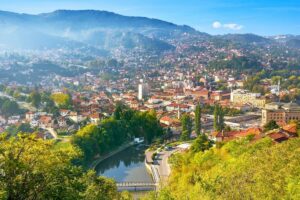Santos - Travel Guide
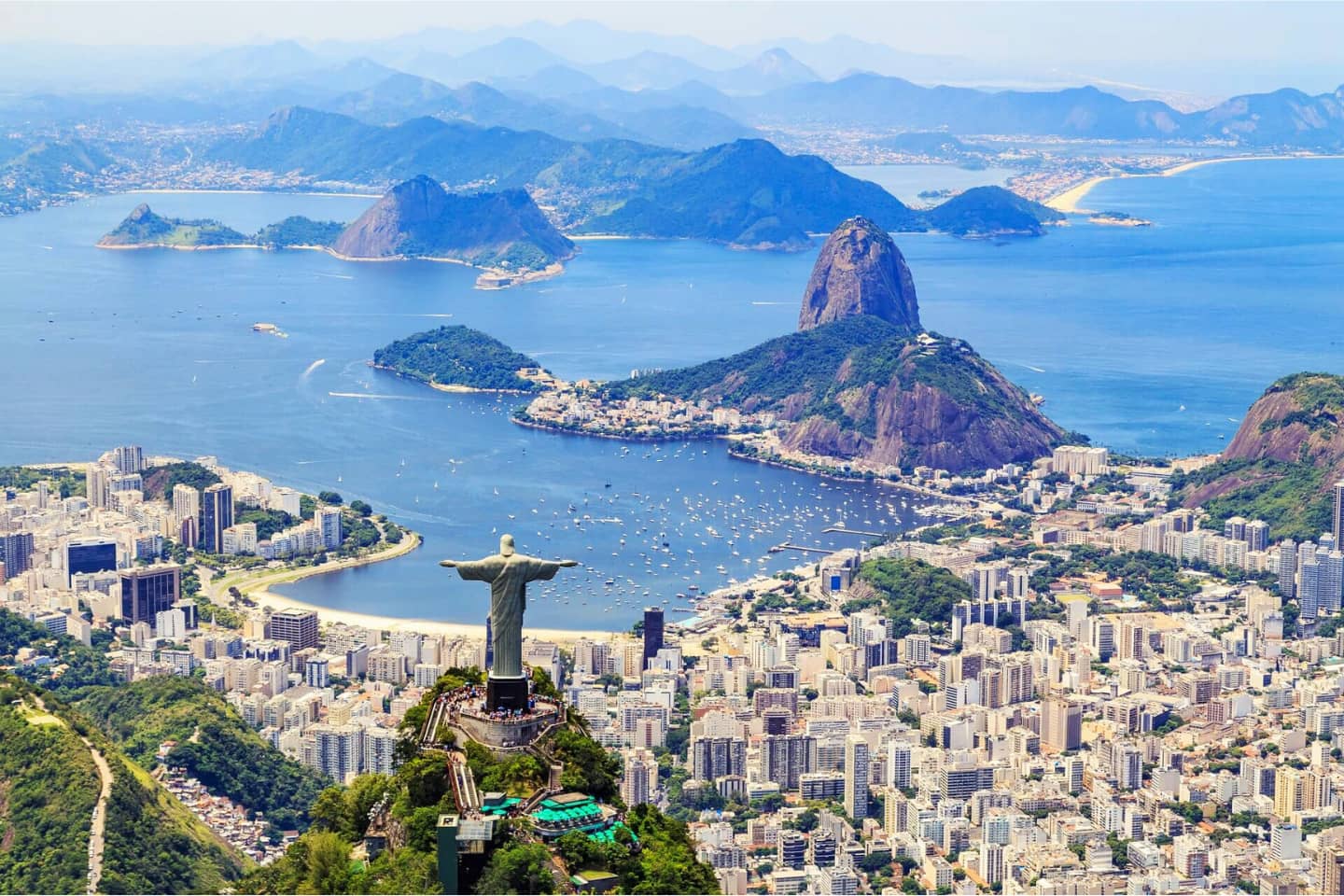
- Jose Carlos Costa
Santos, discovering the charms of this coastal city in the state of São Paulo.
It is a city that combines history, nature and culture. Known for being home to the largest coastal garden in the world, it enchants visitors with its well-kept beaches and tree-lined promenades.
The historic center reveals colonial mansions and the famous Coffee Museum. For those who enjoy ecotourism, Morro do Monte Serrat offers a spectacular view. In addition, it is impossible to talk about Santos without mentioning Santos Futebol Clube and Pelé. Ideal for a weekend getaway, the city combines leisure, good cuisine and easy access from the capital of São Paulo.
Table of Content
Is Santos worth visiting? A jewel on the coast of São Paulo!
Yes, it’s worth it! Santos is a coastal city that combines history, vibrant culture and natural beauty.
Santos is a must-see destination on the coast of São Paulo, less than 80 km from the capital of São Paulo!
Its extensive urban beaches, such as the iconic Praia do Gonzaga with its seaside gardens, invite you to relax and play sports. It also has the largest seaside garden in the world. Its architecture combines colonial mansions, historic buildings and modern areas.
The city is full of historical heritage, visible in its old mansions and in the revitalized historic center, where the past meets modernity. Santos also offers a diverse gastronomy, from traditional seafood to international cuisine, and a welcoming atmosphere that wins over all visitors. If you’re looking for a complete experience, with sun, sea, culture and good food, Santos is your next destination!
Santos Culture
The culture of Santos has deep and diverse roots. Shaped by its port history and the diversity of peoples who settled here. The city was one of the most important points of colonial Brazil and played a significant role in the coffee cycle and the development of the port. This is reflected in its historical heritage, in the old town and in museums such as the Café.
Indigenous roots have mixed with Portuguese, African and immigrant heritage from various parts of the world, resulting in unique cultural manifestations.
Santos also breathes art. The Coliseu Theater, the Sacred Art Museum and the galleries scattered throughout the city show how local cultural production is active and varied.
Local handicrafts, with their pieces inspired by the sea and nature, reflect the caiçara identity.
As for gastronomy, seafood, codfish cakes and typical coastal dishes stand out. The city has an active cultural calendar all year round, with festivals, exhibitions and performances.
Popular festivals, such as the traditional Carnival and religious celebrations, demonstrate the liveliness of the community. In addition, the city’s museums and cultural centers preserve and promote this rich history and the various forms of artistic expression, providing visitors with an immersion into the soul of Santos.
When to go to Santos?
Santos offers many leisure options all year round.
Depending on what you are looking for—beach, cultural tourism, less crowds or milder temperatures—there is an ideal time for you. The main tourist is the people from São Paulo who love the beach at any time of the year. There is always an excuse to go to the beach.
Summer (December to March):
What to expect?
This is the hottest season of the year in Santos, with high temperatures and high humidity. The days are long and sunny, perfect for enjoying the beaches and outdoor activities. The city is busier due to school holidays and the large number of tourists. Highlights of the season: Busy beaches: Gonzaga, José Menino and Itararé beaches are bustling with tourists and locals, offering a variety of leisure and beach sports options. Parties and events: Summer in Santos is marked by concerts, sporting and cultural events on the waterfront, providing plenty of entertainment. Summer rains: Rain showers are common in the late afternoon, but they are usually temporary and do not usually disrupt sightseeing. High season: Prices for accommodation and services tend to be higher at this time, so it is recommended to book in advance.
Highlights of the season:
- Street carnival: lively street parties and intense cultural programming. Vibrant waterfront: full kiosks, street markets and outdoor concerts.
- High temperatures: get your sunscreen ready and stay hydrated!
- High season: prices go up, book in advance.
Autumn (April to June):
What to expect?
Temperatures start to get milder, with sunny days and cooler nights. Humidity decreases, making the weather more pleasant for outdoor activities. The city is less crowded than in the summer. Highlights of the season: Pleasant weather for walks: This is a great time to explore the historic center, go on nature trails and visit the tourist attractions without the intense summer heat. Quieter beaches: The beaches are less crowded, ideal for those looking for relaxation and peace. Gastronomy: Many restaurants offer gastronomic festivals at more affordable prices.
Highlights of the season:
- Historical tours: The old town and museums are quieter.
- Gastronomy: This is the perfect time to sample local flavors at a leisurely pace.
- Moderate prices: ideal for those who want to spend less.
Winter (July to September):
What to expect?
This is the coldest and driest season of the year in Santos, with temperatures that can drop, especially at night.
Days are usually sunny, but with cooler temperatures. Highlights of the season: Cozy atmosphere: This is a good time to enjoy the city’s cafes and restaurants, as well as visit museums and art galleries.
Cultural events: Santos often hosts cultural events and themed festivals during the winter.
Lower prices: The low season usually offers more affordable prices on accommodation and tours.
Highlights of the season:
- Cultural tourism is on the rise.
- Good deals on accommodation.
- A great time to photograph the city without the crowds.
Spring (October to November):
What to expect?
Temperatures gradually start to rise, flowers bloom and the city takes on vibrant colors. The days get longer and sunnier, with pleasant weather. Highlights of the season: Lush nature:
The city’s waterfront gardens and parks become even more beautiful when the flowers bloom. Ideal weather for outdoor activities: This is a great time for bike rides, walks and enjoying the beaches before the peak season. Spring events: The city can host flower festivals and seasonal events.
Highlights of the season:
- The waterfront garden is in bloom.
- Ideal temperatures for all activities.
- Cultural events and fairs are highlighted.
Conclusion: what is the best time?
If you want the beach and excitement, go in the summer. If you prefer a more relaxed and economical climate, choose autumn or winter. Spring is a wonderful middle ground.
If you can avoid the weekends, you can also get a good deal, as the beaches are less crowded.
How to get to Santos
Santos is strategically located and can be reached by various means of transportation:
- By car: The main highways that connect Santos to other cities are the Anchieta Highway (SP-150) and the Imigrantes Highway (SP-160), which connect it directly to São Paulo. Coming from the northern coast, the Rio-Santos Highway (SP-055) is the main access route.
- By bus: The Santos Bus Terminal receives buses daily from various cities in the state of São Paulo and other states in Brazil. Companies such as Cometa, Viação Piracicabana and others offer regular services to the city.
- By plane: The closest airport to Santos is Guarulhos International Airport (GRU) and Congonhas Airport (CGH), both located in Greater São Paulo. From the airport, you can take an executive bus, transfer or ride-sharing app to Santos, with a journey time of approximately 1 to 2 hours, depending on traffic.
- ByShip: Santos is one of the main cruise stops on the Brazilian coast.
GET YOUR FREE TRAVEL STARTER KIT
Enter your email and receive planning tips including a step-by-step checklist, how to pack, and more so you can plan your trip like a pro!

Main Tourist Attractions in Santos
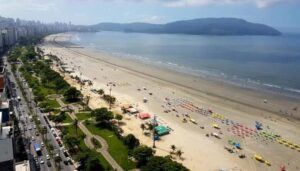
Gonzaga Beach and its Gardens:
Gonzaga Beach is the heart of Santos, a long stretch of fine sand bathed by calm and inviting waters.
It has over 7 km of beach, with a tree-lined promenade, bike path, well-kept gardens and areas for practicing sports. It is perfect for walking or cycling, running or simply sitting and relaxing.
Its famous beachfront gardens, the largest beach gardens in the world, are a spectacle in themselves, with flowerbeds, sculptures and leisure spaces for all ages.
The beach offers a variety of kiosks and restaurants, where you can enjoy local cuisine with your feet in the sand. In addition to being a meeting point for families and friends, Gonzaga hosts several cultural and sporting events throughout the year, making it a vibrant and lively place. The complete tourist infrastructure, with hotels, shops and services, ensures a comfortable and convenient stay for visitors.
Historic Center of Santos: A journey through time:
Exploring the Historic Center of Santos is like taking a journey through time. Preserving the architecture of its old mansions and cobblestone streets, the center tells stories of a glorious past, when the port of Santos was one of the most important in the world.
The Official Coffee Exchange, an imposing building that now houses the Coffee Museum, is a must-see to understand the importance of the bean in the history of Brazil and the city.
The Pantheon dos Andradas, a richly decorated mausoleum, holds the remains of important figures of Brazilian independence.
Strolling along XV de Novembro Street, with its historic buildings and traditional shops, is like feeling the atmosphere of Santos of yesteryear. The revitalization of the area has brought new restaurants, cafes and cultural spaces, making the center a pleasant place to stroll, learn and enjoy the city’s rich historical and cultural heritage.
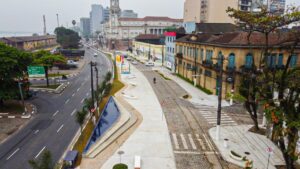

Coffee Museum
Located in a historic building that was once the Official Coffee Exchange, the Coffee Museum is a true journey through time. It shows how coffee boosted the Brazilian economy and transformed Santos into an internationally important commercial center.
The museum is interactive, with permanent and temporary exhibitions, old machinery and lots of interesting information. The architecture of the building is a sight in itself, with stained glass windows, marble and sculptures that recall the wealth of the time. At the end of the tour, you can also try specialty coffees at the on-site café.
Monte Serrat: Panoramic views of the city of Santos and history:
Located on top of a hill with a privileged view of the entire city, Monte Serrat offers a unique experience in Santos. To reach the top, you can use a charming funicular cable car, which provides a gentle climb and beautiful landscapes.
At the top, you will find the Chapel of Our Lady of Monte Serrat, the city’s patron saint, a place of faith and history. In addition to its religious importance, the mountain offers a spectacular 360-degree panoramic view of Santos, Baixada Santista and the ocean.
It is the perfect place to enjoy the sunset and take memorable photos. The structure at the top has a restaurant and areas for relaxation, making the visit even more enjoyable. The combination of history, religion and a breathtaking view makes Monte Serrat an unmissable attraction in Santos.
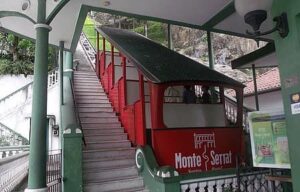
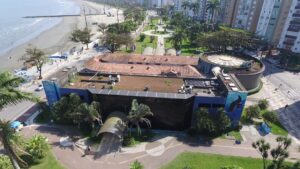
Santos Municipal Aquarium:
Considered one of the largest and most important aquariums in Latin America, the Santos Municipal Aquarium is a fascinating dive into the marine and freshwater world. With several tanks that reproduce different ecosystems, visitors can observe a wide variety of species up close, such as sharks, penguins, sea turtles, colorful fish and much more.
The facilities are modern and educational, providing information on the biology and conservation of the species. The underwater tunnel is one of the most impressive attractions, allowing you to walk underneath a tank full of marine life.
The aquarium is an attraction for all ages, offering an educational and fun experience for families, students and nature lovers. It is a unique opportunity to discover the rich marine biodiversity of the region and learn about the importance of preserving the oceans.
How to get around Santos
Santos offers several options for getting around the city, prioritizing sustainable mobility and easy access to tourist attractions:
On foot:
Walking is an excellent way to explore the beachfront, especially the Gonzaga region, where attractions are close to each other. The boardwalks are wide and well-maintained, inviting you to take peaceful strolls with a view of the sea. The historic center is also compact and ideal for exploring on foot, allowing you to appreciate the details of the architecture and the local atmosphere. Walking around the city provides a greater immersion in Santos life, allowing you to discover small shops, charming cafes and feel the rhythm of the city. In addition, many tourist attractions, such as museums and churches, are located in areas that are easily accessible on foot, making exploring more practical and economical.
Public Transportation:
Santos’ public transportation system is efficient and covers the entire city, with several bus lines that connect neighborhoods, beaches and the center. Buses are an economical option for getting around and allow you to access most tourist attractions. In addition to conventional buses, Santos has a Light Rail Vehicle (VLT), which connects the city center to the coast, providing easy access to beaches and other points of interest along the route. The VLT is modern, comfortable and a quick alternative to avoid traffic during rush hour. Using public transportation is a practical and sustainable way to get to know the city, in addition to providing greater contact with the daily lives of local residents.
Bicycle:
Santos has an extensive cycle network, with well-marked bike paths along the coast and on several streets in the city. Renting a bike is a great option for exploring the coast independently and enjoying the sea breeze. Several companies offer bike rental services, with options for different needs and durations. Cycling around the city allows for closer contact with nature and the daily lives of residents, in addition to being an enjoyable physical activity. Many tourist attractions are accessible by bike, making this a practical and fun option for getting around.
Taxis and Transportation Apps:
Taxis are available at various points in the city and can be a convenient option for quicker trips or for groups. Transportation apps such as Uber and 99 also operate in Santos, offering an alternative transportation option with variable prices and the possibility of ordering a car via cell phone. This option can be more comfortable for longer trips or for those seeking more privacy.
Tourist Bus:
For those who want to see the city’s main tourist attractions in a panoramic way and with information about each location, the tourist bus can be a good option. It usually follows a pre-defined route, with stops at the main attractions, allowing passengers to get on and off at the places of interest.
Costs
Costs in Santos can vary greatly depending on the travel style and preferences of each traveler. Below, we provide a daily estimate in US dollars for three types of travelers.
Note: These values are estimates only and may vary depending on the time of year, promotions and individual choices. It is always advisable to research accommodation and tour prices in advance.
Economic
Staying in hostels using shared dormitories, making your own food and/or eating at local and cheap restaurants, using local transport, exploring the city on foot and taking free or cheap tours.
Meals: $15 – $25 (street food, cheap local restaurants, markets)
Accommodation: $10 – $20 (shared dorm in hostel)
Transportation: $5 – $10 (public transport, walking)
Sightseeing: $0 – $10 (exploring the city on foot, beaches, some free or low-cost attractions)
Total daily cost: $30 – $65
intermediary
Staying in hostels/budget hotels in private rooms, eating in average restaurants, going to major paid attractions, using some taxis and Uber.
Meals: $30 – $50 (mid-priced restaurants, some meals in more touristy areas)
Accommodation: $30 – $60 (private room in a hostel or budget hotel)
Transportation: $10 – $20 (public transportation, some taxis or ride-sharing)
Tours: $20 – $40 (major paid attractions, such as the Aquarium and Monte Serrat)
Total daily cost: $90 – $170
Luxurious
Staying in the best hotels, going to all the attractions, hiring more sophisticated packages such as using a helicopter, etc.
Meals: $70 – $150+ (fine dining, fine dining experiences)
Accommodation: $100 – $300+ (luxury hotels, ocean view suites)
Transportation: $30 – $70+ (taxis, ride-hailing, car rental with driver)
Tours: $50 – $150+ (exclusive tour packages, boat tours, personalized experiences)
Total daily cost: $250 – $670+
Table of Content
Security
In general, Santos is considered a safe city for tourists, but as in any urban destination, it is important to take some precautions to ensure a smooth trip:
Keep in mind the 15 foolproof tips for traveling safely in any country.
As well as the reinforcement of the actions that you should take when traveling to Brazil in Brazil with Safety: Travel More and Better
Safety Recommendations in Santos:
Money and Valuables:
- Carry little cash and avoid showing off jewelry or other valuables.
- Prefer to use credit and debit cards, which are accepted in almost all places.
Using the Beaches:
- Do not leave your belongings abandoned on the beach, even for a short period.
- Keep your belongings in a safe place, such as a backpack or discreet bag.
- Be aware of the currents in the sea, especially on more remote beaches.
- Do not venture into waters that you are not familiar with.
Getting Around:
- Use taxis or public transportation to get around, especially at night. Avoid walking alone on deserted or poorly lit streets.
- Hydration: The weather in Santos can be hot and humid, especially in the summer. Drink plenty of water to stay hydrated.
- Sunscreen: Use sunscreen daily, even on cloudy days, to protect your skin from UV rays.
Be aware of your surroundings:
- Be aware of your surroundings, especially in crowds.
- Pay attention to the people around you and avoid isolating yourself in deserted or dark places.
- Be careful around the port: Although the historic center is safe, the areas closest to the port can be very busy and require a little more attention.
General Safety:
- Avoid talking or using your cell phone on public transport.
- Do not use GPS, as it can lead to dangerous places.
- Plan the places you want to visit and ask the police or shops for directions.
- If you plan to stand on a corner, be extra vigilant and, if possible, do so on a busy street.
Behavior:
- At night, dress like the locals.
- Use your cameras safely and pay close attention.
- Be discreet and avoid attracting attention.
- Communities:
Avoid sightseeing in communities, especially on foot (on your own). - If you are going on a tour, make sure the company is trustworthy.
Other Tips:
- Whenever possible, try to walk in groups.
- For women, if there is a man in your group, it also helps.
- If there are only women, be extra careful.
- Don’t forget to stay hydrated and protect yourself from the sun.
- If you need help, look for a police officer (dial 190), Women’s Assistance (dial 180), SAMU (Mobile Emergency Care Service) dial 192.
.
Let's travel?
Still have questions or need inspiration?
Check out the Blog section, with lots of unmissable tips and articles that will prepare you to discover incredible destinations.
Your next trip starts here
Ready? Then let's hit the road...
Book your flight.
Finding cheap flights can be difficult and stressful, but with the tips from the Blog and using Skyscanner or Google flights, the task can even be enjoyable.
Today, these are the most complete tools on the market
Book your accommodation.
With that in mind, it’s time to choose your accommodation.
The best tool is Booking.com.
For those who are going to use hostels, the best tool is Hostelworld.
I have used both very often and always find the best prices.
Get your insurance
Insurance is something we never want to use, but it is traumatic if we need it and don’t have it.
It will cover the costs of any eventuality of illness, injury, theft and/or cancellations of tickets, hotels, etc.
I have used WorldNomads or Assistcard, which always have the insurance with the coverage that travelers need, in addition to having coverage worldwide.
Post Relacionados



